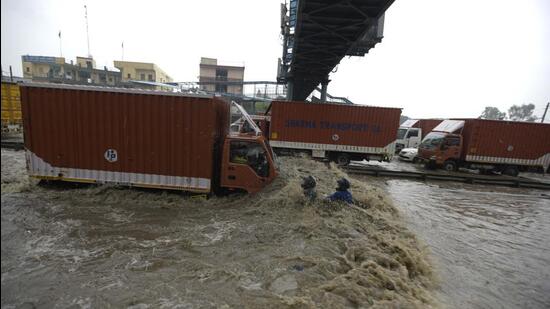Delhi’s blow-hot-blow-cold September
Rains – first the lack of it, and then an almost continuous six-day spell – are the reason for these wild fluctuations
In what seems like a continuation of the weather becoming more volatile in the national Capital, Delhi has swung from seeing the seventh hottest week – measured in terms of average maximum temperature – in the first week of September to experiencing the seventh coldest week by the third week of the month. Rains – first the lack of it, and then an almost continuous six-day spell – are the reason for these wild fluctuations. Here are three charts which explain this in detail.

Week ending September 21 was the 7th coldest by maximum temperature since 1951, but…
The average maximum temperature – a reflection of daytime temperatures – in Delhi in the week ending September 21 was 32.3°C. This is 2.1°C less than the average in the 1951-1980 period, considered the normal; and the seventh lowest for the third week of September since 1951, the earliest period for which this data is available. This shows that the rain in Delhi in the past week has indeed cooled the city-state substantially. However, this is very different from how the month began. The average maximum in the first week of September was 2.4 degrees higher than the normal, and record-breaking on the other extreme: it was the seventh hottest first week of September since 1951. Even the second week was 1.6 degrees warmer than normal and the 16th hottest since 1951. Two hot weeks against one cold week means that the month’s average is tilted towards the hotter end. The first three-week period of September this year is the 20th hottest since 1951 and 0.6 degrees warmer than normal.
To be sure, temperature statistics throughout this analysis are based on IMD’s gridded database, which covers an area bigger than the administrative boundaries of Delhi. While this may affect precise ranks, the general trend is likely to be unaffected because temperature deviations in general do not vary much over a short distance.
See Chart 1: Daily maximum temperature in September in Delhi in 2022 versus 1951-1980 average (°C)
Minimum temperatures are one of the highest for all three weeks; 2nd highest overall
Even nights have not been cooler on average in September. The average minimum temperature for September in Delhi is 26.1°C, 1.6 degrees warmer than normal. This is the second hottest since 1951. However, this should not be surprising. The normal minimums for the first, second, and third week of September are 25°C, 24.5 °C, and 24°C respectively. The minimum Delhi actually saw was 26.7°C, 27°C, and 24.6°C – the highest, the second highest, and 16th highest for those weeks since 1951. The rain in the past week decreased night time temperatures also, but not nearly as much as day-time temperatures. While maximum temperature was below normal on six days in the past eight days (see Chart 1), minimum was below normal on only two.
See Chart 2: Daily minimum temperature in September in Delhi in 2022 versus 1951-1980 average (°C)
Why did nights not cool down as much as days?
The answer lies in rainfall. Overcast conditions have meant that the earth has not been able to lose heat fast at night. This is because clouds trap the heat that earth loses after sunset. This can be seen clearly if one reads rainfall data with the difference between maximum and minimum temperature in Delhi. Rainfall has increased in each of the three weeks of September, with the most rainfall in the third week. Night-time or minimum temperature fell the most below the day-time temperature in the first week and the least in the third week. The rainfall pattern also explains why the first half of September was hot. The first two weeks had a deficit of 93% and 69% compared to the 1961-2010 average, leading to a 35% deficit so far despite the 140% surplus in the last week.
The national Capital saw a similar pattern in January this year. Delhi received the fourth-highest rainfall for January this year since 1901 (rainfall data is available for a longer period), pushing the average day temperature to the lowest since 1951. However, the nights in January were the second hottest since 1951 on average, just as September so far is the second hottest (in terms of night temperatures) since 1951.
See Chart 3: Week-wise rainfall in Delhi and difference between maximum and minimum temperature
Get Current Updates on India News, Ram Navami Live Updates , Lok Sabha Election 2024 live, Elections 2024, Election 2024 Date along with Latest News and Top Headlines from India and around the world.




